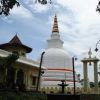මහියංගන රජ මහා විහාරය
Mahiyangana Raja Maha Vihara is an ancient Buddhist temple in Sri Lanka. It is believed to be the site of Gautama Buddha's first visit to the country, and is one of the Solosmasthana, the 16 sacred religious locations in Sri Lanka.
Historical sources, including the ancient chronicle Mahawamsa, record that the Buddha visited the Mahiyangana area in the ninth month after he attained enlightenment, which was his first visit to the country. According to the Mahawamsa, Sri Lanka was inhabited by Yakshas at the time. It says that the Buddha subdued the Yakshas there and held a discourse on Dhamma with them. They were then sent to an island named Giri so that the country would be "purified" and Buddhism could be established there later on, where it would prevail "in all its glory".
A Yakka chieftain named Saman (who is now regarded as a deity) attained Sotāpanna (First stage in liberation) after listening to the Buddha's discourse and requested a token from the Buddha that they could worship in his absence. The Buddha had given him a handful of hair from his head, which Saman later enshrined in a small stupa, 10 feet (3.0 m) in height. This was the first stupa to be built in Sri Lanka.
After the parinirvana of the Buddha, an Arahant named Sarabhu brought the Buddha's left clavicle bone, which had been recovered from the funeral pyre. This relic was also enshrined within the same stupa, which was enlarged to a height of 18 feet (5.5 m).
Several kings have since renovated and enlarged this stupa, including Dutugemunu raised it to a height of 120 feet (37 m). Other rulers such as Voharikatissa, Sena II, Vijayabahu I and Kirthi Sri Rajasingha have maintained work at the temple. In 1942, a society was formed for the renovation of the temple under Rt Hon. D. S. Senanayake the first Prime Minister of Sri Lanka. Reconstruction work began in 1953 and ended in 1980 with the completion of a new pinnacle for the stupa.







